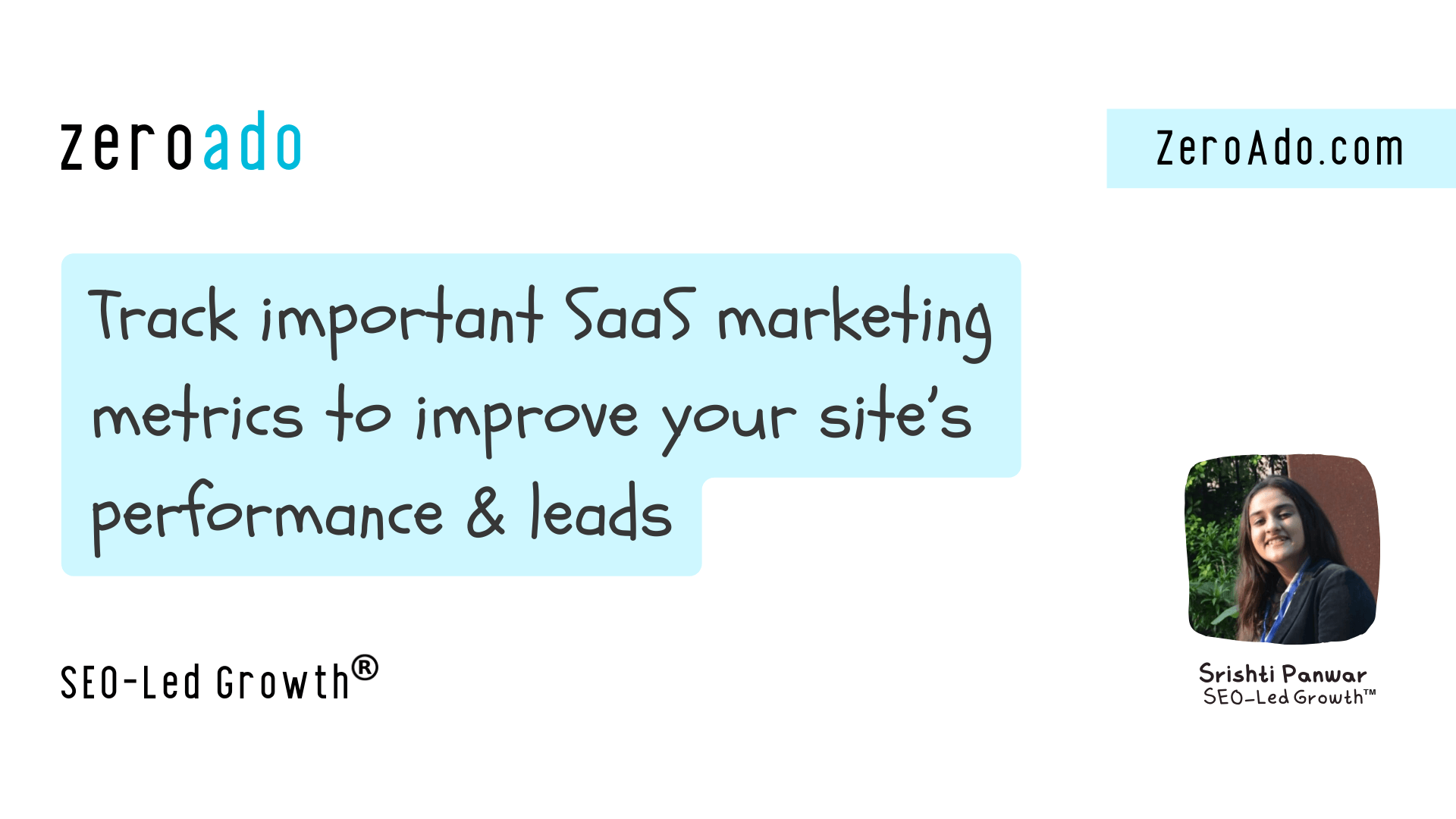You cannot correct something when you do not know the problem in the first place. Similarly, you cannot improve in a field if you do not find the scope of improvement in the first place. SaaS marketing metrics are tools that help you find the problem. They are also tools that show you that there is scope of improvement for your business.
If you have a SaaS brand then I know that you already are a visionary. Vision could be anything, being known, capital, or leaving a legacy. But if you do not keep track of how close you are to that vision, then be prepared for that vision and your business to perish.
Sounds demotivating? Well, that wasn’t the intent. The intent was to let you know how important it is to measure SaaS marketing metrics because they give you the real picture of where your brand stands.
I assure you that every SaaS brand you see in the market right now, is obsessed with numbers and metrics and they have been since the beginning of time. You need to be as well because you might be giving your 110% in efforts but those efforts are not being put in the right direction, if you are not getting even an output equivalent of that or more than that.
I am sure you want to see an upward graph for your business too, so let’s get into the SaaS marketing metrics that you should track to make your business profitable.
- SaaS marketing metrics to track for business success
- Pages with maximum traffic
- New visitors
- Qualified marketing leads
- Marketing channels with most profitable leads
- Conversion rate
- Customer acquisition cost
- Months to recover customer acquisition cost
- Customer lifetime value
- Customer lifetime value to Customer acquisition rate Ratio
- Average sales price
- Customer churn rate
- Customer retention rate
- Active account rate
- Marketing sourced revenue or MSR
- Free users conversion rate
- Lead velocity rate
- Customer satisfaction or Net Promoter Score
- Measure SaaS marketing metrics to scale faster with smart investments
SaaS marketing metrics to track for business success
Anyone can track metrics, however, tracking the right metrics is what makes all the difference. So, to make things easier for you, here I am going to elaborate on the SaaS marketing metrics that your brand needs to evaluate and closely keep track of.
“Measure what is measurable and make measurable what is not so.”
Galileo Galilei

My team and I have curated this list from our collective experience of 15 years of working for SaaS brands and helping them grow from zero to 💯. These are the metrics our clients kept a close track off that helped them reach where they are today.
To make your job even more easy, ZeroAdo has made a calculator for all the necessary metrics. Copy the SaaS Marketing metrics Calculator by ZeroAdo and find out what your SaaS business needs to work upon.
Pages with maximum traffic
Along with tracking your website traffic overall, one thing that you need to keep a close eye on are the pages with maximum traffic. Naturally, these will also be some of your top ranking pages, so keep a close eye on their position.
Along with position, track the impressions, click rate and the top queries this page is ranking for. Ideally, you should track these pages everyday. This is your SEO content which is getting you the maximum traffic and even a slight dip can cause your business harm.
Why should I track these pages?
- So that you hold your top position for the queries at all times and do not lose customers in case there is a change in position and you were too late to notice.
- To analyze the top keywords this page is ranking for and make changes in your content to add those keywords and improve your position for the same.
- To make sure that you never lose sight of the pages that are getting you maximum customers and as soon as there is a small change, you make updates and level up content or SEO efforts to reclaim your position on top.
- To know what your customers are looking for the most and focus your efforts in that direction to convert more sales.
You can keep a track of these pages both in your Google Search Console and other tools like Ahrefs that can send you instant notification if there is a slight change.
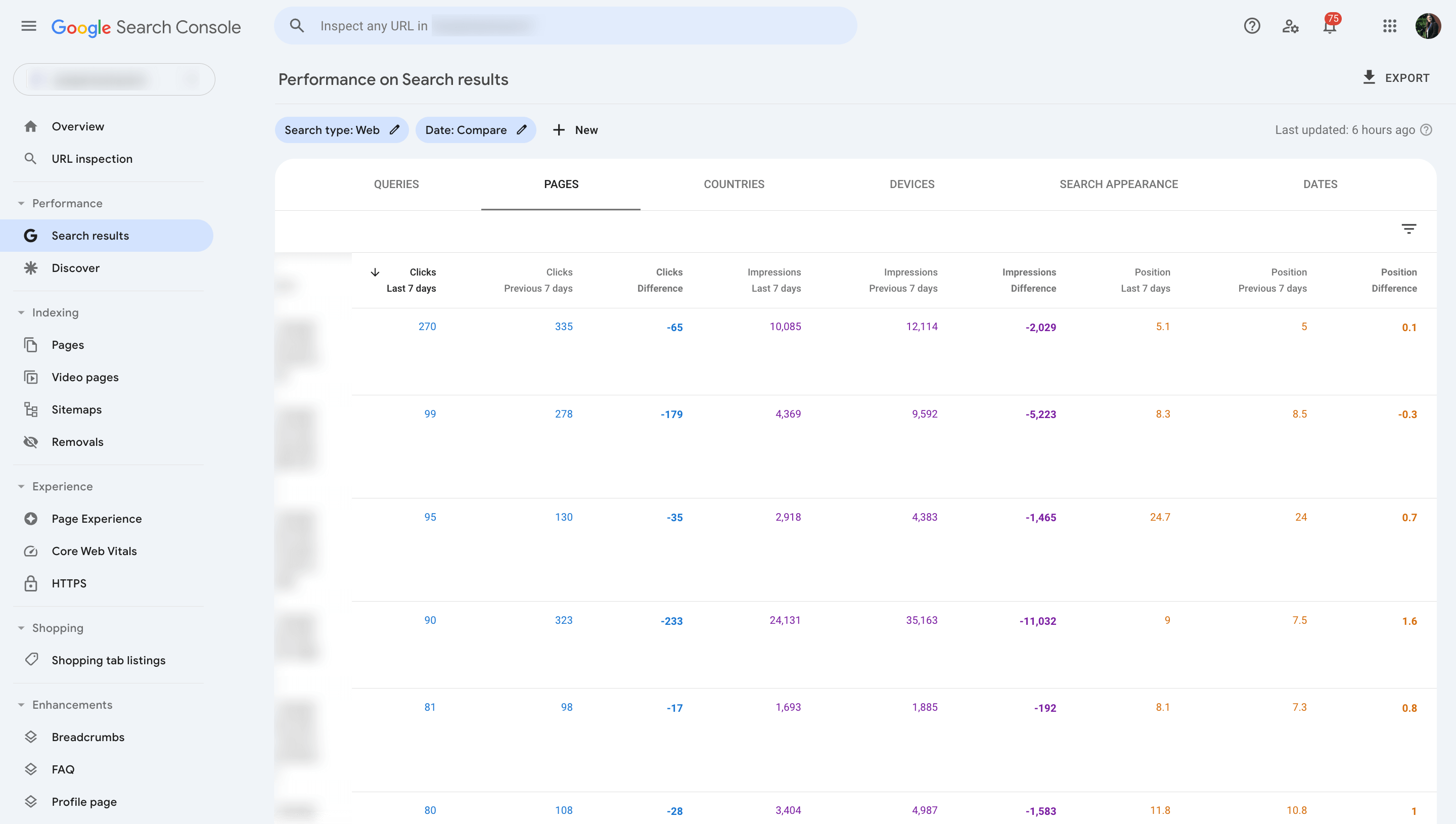
In the above screenshot, you can see the data of the last 7 days compared with the previous period along with the difference between the two. You can utilize these points to then update your content and make sure that your top traffic pages are intact!
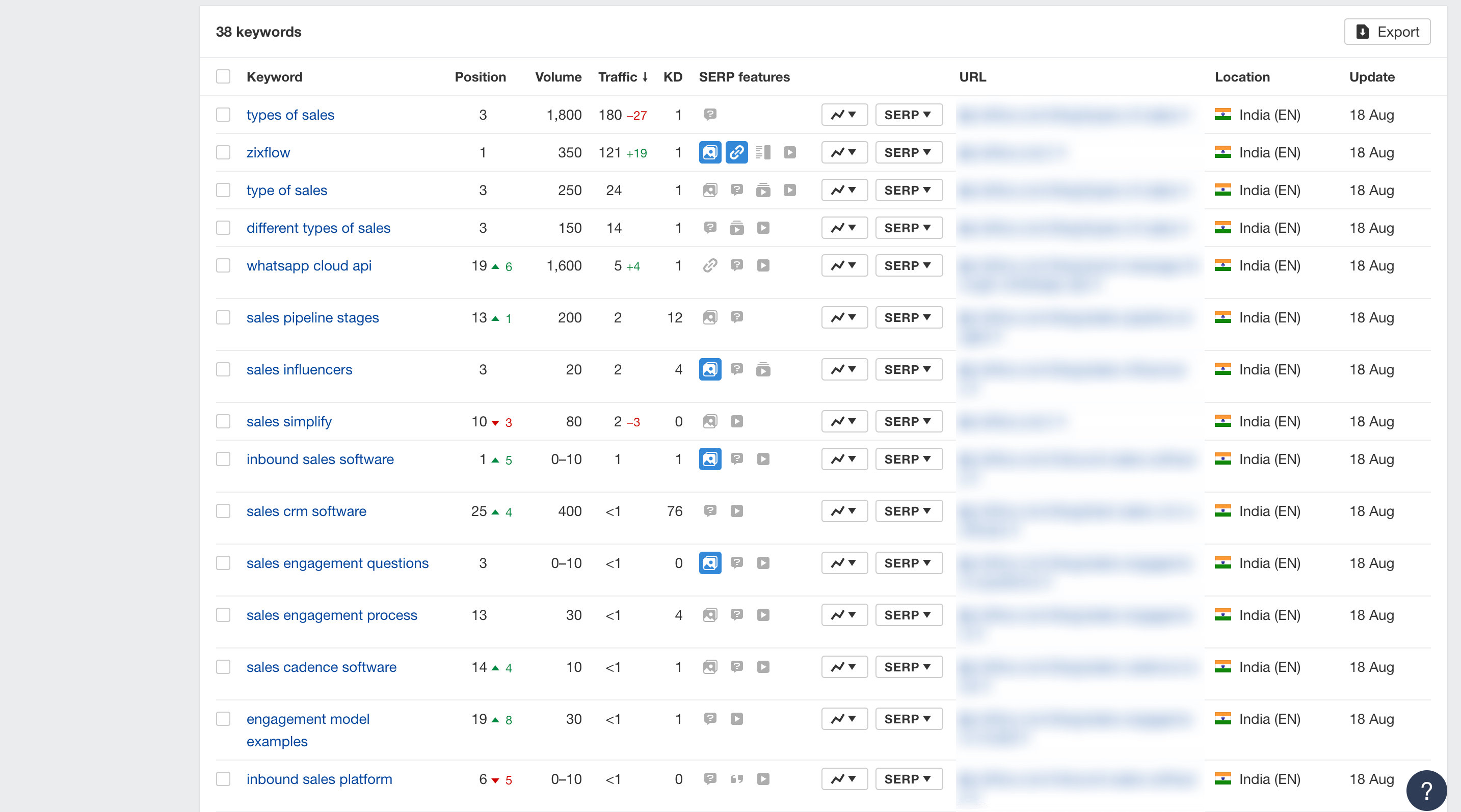
New visitors
As the name suggests, unique visitors refer to the number of unique visits your website has received over a period of time, let’s say a month or a year. In total website traffic, you get the data of repeat visitors as well.
You need to track your unique visitors to be aware of how well your SEO and content marketing is working month-on-month in spreading brand awareness.
For instance, if in the month of July 2024 you got a total 100K visits from 20K unique visitors, and then you get 105k visits from 22k unique visitors in August 2024 then it showcases that your brand awareness is increasing.
Thus, your marketing is working! It is an easy metric to track, and you can check the same in your Google Analytics dashboard.
➡️ Go to the audience section on the left hand side panel of your Google Analytics dashboard.
➡️ Click on All users.
➡️ There you will find the total number of unique visitors or ‘All users’ as Google refers to them.
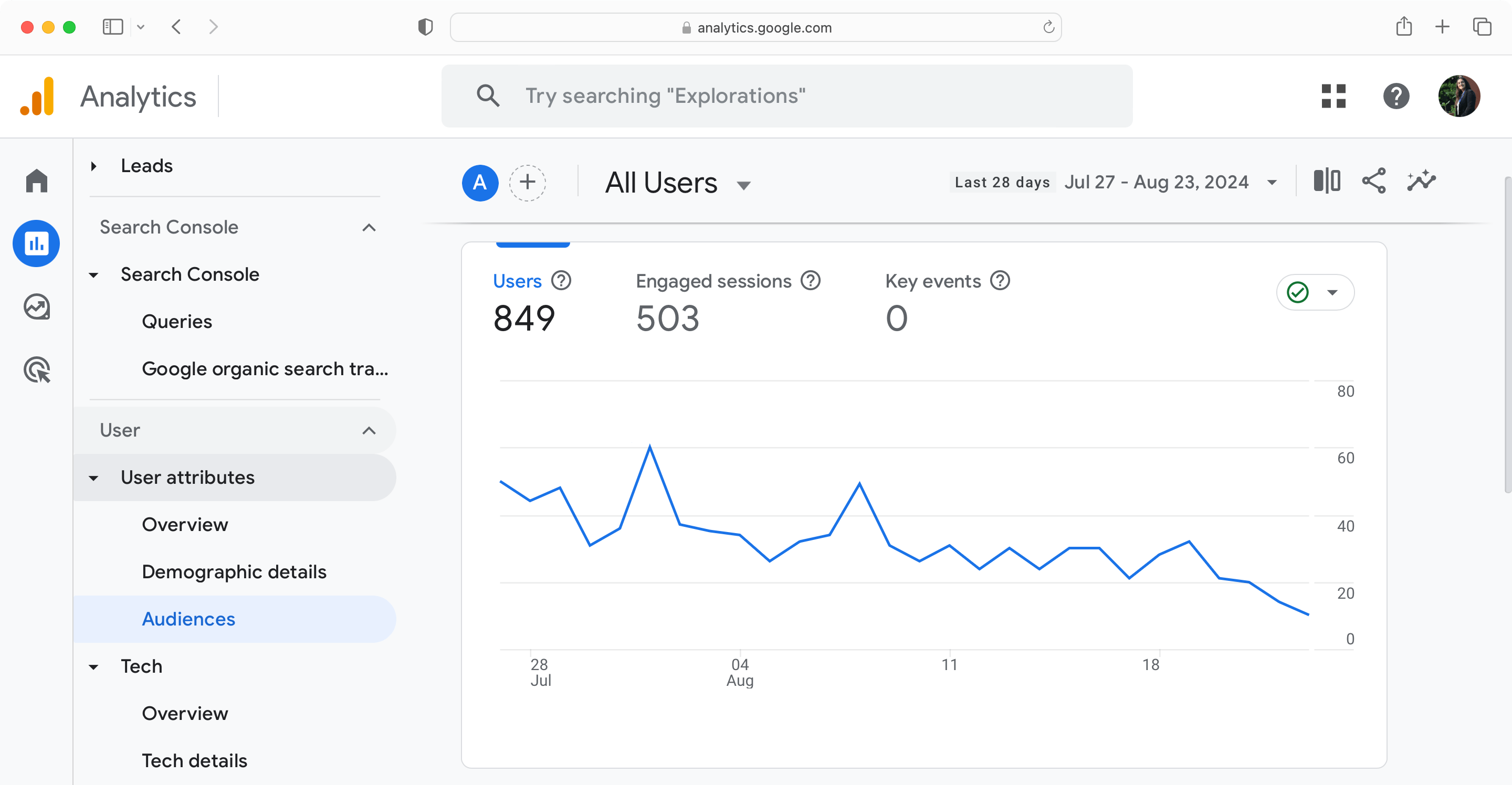
Qualified marketing leads
The number of leads that you are getting which are qualified by your marketing team are called qualified marketing leads. For instance, if your ideal lead is the sales head of a company with MRR USD 1 million, then anyone fitting this criteria would be considered a marketing qualified lead.
This is a subjective metric for each business depending on the ideal customer. However, the more marketing qualified leads you are getting with lesser marketing expenditure the better it is.
Marketing channels with most profitable leads
For every business, there is going to be one marketing channel that gets you the maximum number of qualified leads. You need to find out that channel and then also analyze if that is profitable or not for your business.
If you are getting maximum leads from paid marketing, then also analyze how profitable those leads are and just do not trust the numbers you get upfront.
For instance, through a paid marketing campaign you got 50 leads by spending USD 10,000, for 3 months then each lead cost you USD 200.
However, if by spending the same amount on organic marketing you can get 75 leads then you know which channel you need to choose. Paid marketing might give instant results but organic marketing gives sustained results.
Keeping this subjectivity also in mind, will help you compare better and finally allocate your marketing budget accordingly to make business more profitable.
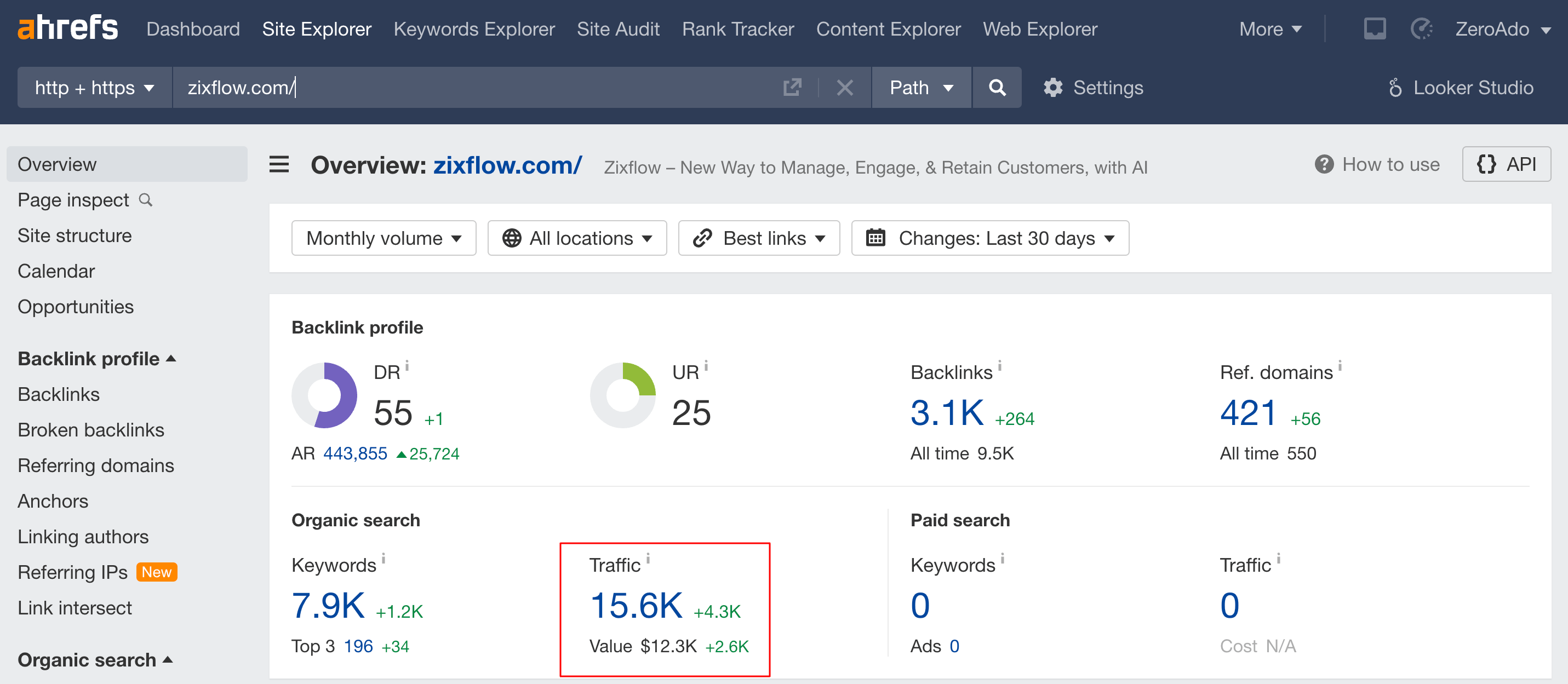
For instance, as seen in the above image, the value of organic traffic of one of ZeroAdo’s SaaS clients is USD 12.3K. Basically that is the same amount they will have to spend on paid marketing to get that traffic.
However, the difference is that paid marketing lasts only for a while but organic marketing sustains.
If they stop the paid marketing then traffic would be gone and so will be the scope of getting qualified leads however, with SEO and organic marketing the traffic stays and instead keeps on increasing only. Because SEO is a customer centric marketing channel.
If the traffic is quality, then so will be your leads and thus more traffic = more leads.
Conversion rate
Conversion refers to the % of leads that got converted into paying customers. Here is how you can calculate it.
| Conversion rate = Number of paying customers / Total number of leads x 100 |
Why should this be one of the key SaaS metrics that you should track?
- To know the health of your sales funnel and find out where your team is lacking.
- If the rate is too low then you need to find out why and close any gaps that there might be.
- To keep track of the increase and decrease in lead to customer rate month-on-month, so that changes can be made if you see a dip.
Access your conversion rate calculator.
Customer acquisition cost
Customer acquisition cost refers to the amount you need to spend to acquire one customer for your platform. For instance, you spent USD 1000 on SaaS content writing in total in one month and you got 10 customers out of it.
Then CAC would be 100 per customer. Now if it is profitable or not, that depends on business to business depending on other metrics like lifetime value of the customer, pricing of your product, and customer retention which we will discuss going further.
| Customer Acquisition Cost = Total amount spent on marketing activities / Number of new customers acquired |
Calculate your SaaS business’s customer acquisition cost.
Months to recover customer acquisition cost
The number of months it takes for a customer to get you to break even point of how much you have spent to acquire them is called months to recover CAC.
In simple terms, how long does it take for a customer to start being profitable for your business.
This is calculated by dividing your CAC to your monthly recurring revenue from the customer and then multiplying it by your gross margin on the product.
For instance, if it took you USD 100 to acquire a customer the monthly revenue they are adding is USD 50 and your gross margin on the product is say 50% then the number of months to recover this would be 4 months.
Here is how!
| Months to recover CAC = CAC / (MRR x Gross margin) |
Months to recover CAC = 100/(50 x .50)
Months to recover CAC = 100/25
Months to recover CAC = 4
As your business grows, you want this number to keep reducing to become profitable as soon as possible. Having this number reduced month-on-month is a sign of growth that your business is looking for because being on Google’s first page is not enough, nor is acquiring a customer to build a profitable business.
Find out how many months it will take you to recover CAC.
Customer lifetime value
Customer lifetime value refers to the total revenue generated from a customer during the period in which they were actively using your product.
This is one of the most crucial metrics as it also determines the ROI you are getting from your marketing expenditure and also helps you find out the amount you need to spend in acquiring more such customers.
Here is how you can calculate CLV.
| Customer lifetime value = Customer value × Average customer lifespan |
The more the customer lifetime value is for your business the better is the ROI you are getting from your marketing expenditure.
Want to know what your customers’ lifetime value is?
Customer lifetime value to Customer acquisition rate Ratio
To have profitable business and marketing campaigns you need to keep track of the ratio of your CLV to CAC. It gives you an upfront number of how much you are spending one time on a customer to get returns. You can calculate it the following way.
| CLV:CAC = CLV / CAC |
A 3:1 is often considered ideal in the sense that if you are spending USD 1 on acquiring a customer then they should at least make you USD 3 in return. If this ratio is below that, then it might be a sign for you to update your marketing campaigns as you might be spending too much on them for too little results.
The higher the ratio, the more profitable a business is and that also gives you the space and opportunity to invest and experiment in other marketing models to become even more profitable.
Calculate your business’s CLV:CAC.
Average sales price
Average sales price refers to the average price at which you are selling your product. As a SaaS product, you often offer multiple packages to fit the variety of budgets that your customers might have. Through the average sales price you find out the amount most of your customers are likely to spend.
When you have that insight with you – it helps you structure your product pricing better and allocate relevant budget to SaaS content marketing, SaaS SEO, and other segments to have a profitable outcome.
It is calculated by dividing total revenue to the number of units sold over a period of time.
| Average Monthly Sales Price = Total monthly revenue / Total number of units sold |
For instance, if you sold 100 units in total, and revenue generated is USD 1500 then average sale spruce is USD 15. Also, ideally, average sales price should also be higher than CAC to ensure that your marketing campaigns are all running profitably.
Do you know what your average sales price is? Calculate ASP now!
Customer churn rate
Customer churn rate refers to the percentage of customers who opted out of your software and canceled your subscription. Tracking this is crucial due to the following reasons.
- You get to know how effective you are in retaining your customers.
- The churn rate determines the overall loss or profit you might have made in marketing to finally convert your customers.
- An increasing churn rate showcases that you need to make immediate changes to both your sales and marketing strategies thus, helping you act at the right time.
Customer churn rate is calculated by dividing the number of customers lost to the number of customers at the beginning of the time frame you are taking multiplied by 100.
| Customer churn rate = (Number of lost customers / Number of customers at the beginning of the time period) x 100 |
Calculate your customer churn rate.
Customer retention rate
The biggest mistake you can make as a SaaS business is thinking that customer churn rate and customer retention rate are related. They are definitely the two sides of the same coin yet they are very different from each other, let’s look at how.
Customer churn rate means the customers who stopped using your product almost instantly, while retention rate means the customers who will continue to use your product for a long long time. You might think that reducing churn rate will increase retention rate, while that sounds about right, it is not as easy as it seems.
The efforts made to reduce churn rate, and in customer retention are poles apart. Because while retaining the customer you are not only trying to keep them with your business for longer but also increase the profits your business is getting.
Activities like upselling, cross selling and regularly publishing and sharing different types of SEO content resources for engagement are a part of customer retention plan. While at the churn rate you are just asking the customer to stay with you at any cost.
Now that you know how the two differentiate, here is how you can calculate customer retention rate.
| CRR = [(Ending customers – New customers) / Starting customers] x 100 |
Active account rate
Active accounts refers to the number of customers that are actively using your SaaS product. You can calculate active account rate by dividing the number of active accounts to the total sign ups and multiply the same by 100.
| Active accounts rate = (Total active users / Total sign ups) x 100 |
Find out what your business’s active account rate is.
Why do I need to calculate it?
- The lower the percentage will be the more you will need to put efforts in email marketing, customer engagement and enhancing customer support.
- Also, lower percentage tells you that the customer lifetime value is on the decrease which is not sustainable for the business in the long run.
- Also, if the rate is constantly falling then you can figure out that your marketing and sales team are not in sync.
Marketing sourced revenue or MSR
Marketing sourced revenue refers to the total revenue that you have made by spending on all marketing efforts combined or individually.
This tells you the ROI you are getting from investing in different marketing channels. If you want a concrete ROI then you can do so by finding the ratio between CAC from marketing channels and CLV of the acquired customers.
Your MSR however is subjective based on the SaaS marketing KPIs that you have set for yourself to track. They could be clicks, traffic, qualified leads, and even conversion rate. Keep that in mind, measure your ROI and figure out what changes you need to make in your marketing efforts.
Free users conversion rate
The free user conversion rate refers to the number of people who got converted into a paying customer after taking the free trial. The better this rate is, the better you know your marketing is. A higher rate means that your marketing campaign is targeting the right set of people.
| Free users conversion rate = (Total number of free sign ups that converted into paying customers / Total free sign ups) x 100 |
Calculate your free users’ conversion rate.
Lead velocity rate
Lead velocity rate is one of the most crucial SaaS marketing metrics you need to track because this metric clearly depicts the efficiency of your marketing efforts like email marketing, coming up with unique SEO content ideas, and pain marketing as well.
Think about it like this, what sounds better to you? 100 leads in one month or 100 leads in a span of 7 months?
I am sure it is the former. Why? Because you want the leads to keep flowing and thus, you want the velocity of the leads to be high month-on-month to know if your marketing efforts are working or not.
Here is how you can calculate it.
| Lead velocity rate = (Number of qualified leads in the current month – Number of qualified leads last month) / Number of qualified leads last month x 100 |
Find out your lead velocity rate.
Customer satisfaction or Net Promoter Score
You must have filled multiple surveys asking you to share how likely you are to recommend a particular brand to those in your network.
That is what is known as Net promoter score. It also depicts the satisfaction of your customers with the services that you are providing, clearly indicating if you need to improve something or not.
Here is what the Net promoter score card says:
- 0-6 [detractors] – They are not likely to promote your brand, rather they might badmouth it instead.
- 7-8 [passives] – These are the ones who will not promote but are refraining to say it to your face.
- 9-10 [promotors] – They are likely to promote your brand.
Your goal here is to find the detractors who are not likely to promote the product and consult with them why, so as to increase their satisfaction with your product and also get word-of-mouth marketing.
You calculate your NPS the following way.
| NPS = % of promoters – % of detractors |
Measure SaaS marketing metrics to scale faster with smart investments
I am certain that you want to build only a profitable business and enduring losses is not what you have in mind. However, businesses are uncertain, while you cannot 100% avoid losses, you can see them coming and then navigate them safely by tracking your SaaS marketing metrics.
Another way to avoid enduring losses, is hiring SaaS SEO agencies that can give you the best ROI on your marketing budget through organic marketing – also one of the most sustainable marketing tools.
So if you are looking for the ultimate business success then hire ZeroAdo, we will not only monitor key SaaS marketing metrics for you, but also get you results that otherwise seem far fetched.
